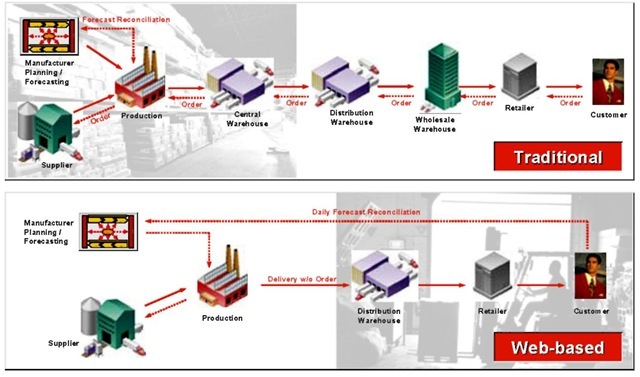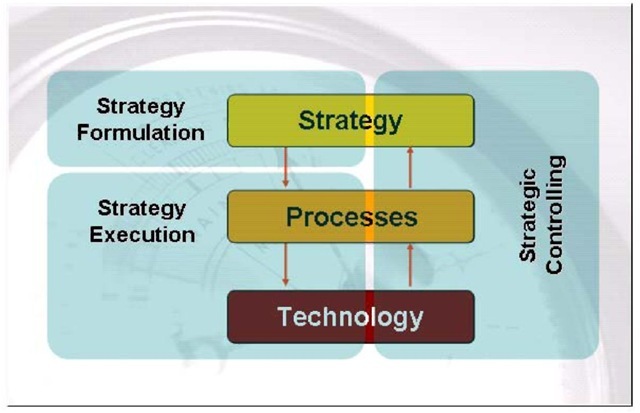INTRODUCTION: SUPPLY CHAIN MANAGEMENT
Supply chain management is a fairly new creature and one that has evolved out of a variety of different enterprise functions over the past two decades. Traditionally, the majority of activities within supply chain management were related to the physical transport of goods from one point to another. Today, we understand supply chain management to include a broader range of activities such as demand planning, purchasing, warehousing, and transportation at the very least. Many authors will also throw production, product, and package design as well as marketing into the definition (Dornier et al., 1998; Schary & Skjett-Larsen, 2001; Taylor, 1997; Gourdin, 2001). For the context of this article, we refer to supply chain management as activities that are related to the planning and fulfillment of market demand. All of the activities within supply chain management can be performed by one or more than one legal entity. We further understand supply chain management as a business process rather than a function or department within a given company. Figure 1 below illustrates the set of core and potential activities as well as supporting ones such as process, performance, and information management.
BACKGROUND: CORPORATE STRATEGY
Strategy refers to the competitive positioning of a company or product in a given market. According to Michael E. Porter, the essence of strategy lies in the activities a company performs – either choosing to perform the same activities differently from rivals or choosing to perform different activities than its rivals (Porter, 1996). These activities can be viewed as distinct activities in some cases or as business processes in others. Ultimately, the execution of activities leads to the occupation of a unique and defensible position from which the firm can outperform its competitors. The degree of defensibility depends on what Porter calls trade-offs: well-defined synergies that tie the activities of a company to one another and create a network for value creation that is harder to imitate than single activities would be. This view of strategy closely ties into the approach of strategic capabilities (Stalk et al., 1992; Hamel & Prahalad, 1990) and also into the more recent approach of the resource-based view (Collis & Montgomery, 1995; Kaplan et al., 2001).
Figure 1. Strategic supply chain activities
FUTURE TRENDS: SUPPLY CHAIN STRATEGY
Before we venture into the definition of supply chain strategy, it is important to clarify the relationship between strategy and activities a bit further. In its simplest form, strategy is the definition of a desired future state of the firm or business unit or product. Activities are either stand-alone tasks or they are chains of tasks, which are de facto business processes. In this sense, strategy drives the definition of processes and processes in turn rely on technologies as much as on other resources in their execution. The explicit dependencies between strategy, process, and technology are illustrated by the framework as shown in Figure 2.
Returning to supply chain management, we can now define supply chain strategy. If corporate strategy is the selection and execution of specific activities in a given firm, then supply chain strategy necessarily is the choice and performance of unique activities within supply and demand management to ultimately achieve higher corporate goals. Further, it is important to differentiate between firms that are primarily driven by supply chain management activities (strategic role) and those where the supply chain is just an enabling function (support role).
In its support role, supply chain management translates corporate strategy into strategic supply chain objectives. These strategic objectives then drive the definition of processes through the choice of activities. Processes, in turn, are supported by supply chain technologies. As a result, supply chain processes and technologies subsequently become a directly dependent function of corporate strategy. Supply chain managers in this situation have to perform three strategy-relevant tasks:
(1) Definition of supply chain activities in close reliance on the essence and intent of corporate strategy.
(2) Creation (as opposed to depletion) of synergy between all supply chain activities as well as towards all other activities of the firm.
(3) Continuous monitoring of strategy achievement throughout the execution of supply chain activities.
Seen in this light, supply chain management actively contributes to corporate strategy achievement and is as important a corporate function as marketing, finance, or human resources. This view of supply chain as a support function has gained in importance over the past few years and will continue to do so.
In the strategic role, supply chain management drives the definition of corporate strategy and thus will translate its own strategic requirements into business processes and technologies. Supply chain management in the strategic role takes on a life of its own in that the dominant ingredients of corporate strategy are all ultimately tasks of supply chain management. The core competency of a company often times is based on supply chain management. The relation between supply chain strategy, processes, and technologies is much more immediate, yet the general relationships remain the same as in the support function.
Figure 2. Strategy framework
CONCLUSION: WEB-BASED SUPPLY CHAIN STRATEGY
As we had initially stated, supply chain management can be performed by one or more than one legal entity. The latter circumstance is characterized by several firms all executing activities within a single, logically coherent supply chain. This situation poses very specific additional challenges that a single firm would not encounter. On one hand, the coordination of supply chain activities now resides with several firms and thus in the hands of several potentially independent actors. On the other hand, supply chain information has to transcend the traditional boundaries of enterprise systems such as enterprise resource planning (ERP), supply chain planning (SCP), or supply chain execution (SCE) systems. These systems were developed in the 70s to early 90s. As a consequence, they were never intended to enable the close sharing of information across enterprise boundaries and beyond the communities of immediate users. Traditional enterprise systems are thus too inflexible and cumbersome to use when it comes to information sharing between various partners. Yet, this sharing of information is exactly what new theoretical concepts such as supply chain collaboration, event management, or visibility require. In fact, these concepts necessitate a shared platform that allows the exchange and filtering of supply chain relevant data and information in order for it to be used by many diverse and highly involved firms. To make things worse, turning enterprise-level systems inside-out to cater to data and information sharing does not seem very feasible due to their high degree of internal complexity.
A possible way around the re-design of enterprise-level systems is the sharing of supply chain data on a common platform such as a Web-accessible database that allows data and reporting structures to be reconfigured as new needs arise. Such a database can be resident in any of the partners’ locations or elsewhere and can provide instrumental support in the coordination of partners as they thrive to accomplish a common goal. Based on our definition of supply chain strategy as the choice and performance of supply chain activities, the partially Web-based execution of supply chain processes constitutes an integral part of the technology layer within the strategy framework illustrated above.
How does this work in a concrete example? Figure 3 illustrates the differences between traditional and Web-based supply chains. What becomes readily apparent is that traditional supply chains rely on slow, error-prone, node-to-node communication that gradually ripples through the system before new information from the point of sale (POS) affects supplier and manufacturing nodes at the opposite end. The occurrence of the bullwhip effect is a good example of the inherent inefficiencies in traditional supply chains (Whang, 1997). Web-based supply chains on the other hand are characterized by a much higher degree of information sharing and also by much faster communication. Naturally, the availability of Web-based technological capabilities as described above allows for a much higher degree of operational effectiveness and strategic efficiency.
Figure 3. Traditional versus Web-based supply chains

The transformation from a traditional to a Web-based supply chain usually takes time and is not easy to accomplish. A key issue for Web-based supply chains lies in the establishment of trust between parties that oftentimes have conflicting goals and need to negotiate their fair share of revenues from a shared financial stream. This latter problem is virtually always a critical factor in supply chain efficiency in that manufacturers, distributors, and wholesalers usually try to reverse-engineer retail revenues and profits based on quantities sold in specific locations. This naturally leads to a lack of trust that can only be overcome by gradual and iterative negotiation. The emergence and proliferation of Web-based supply chain technologies will ultimately contribute to the building of trust as these technologies provide a factual basis for information and pose a strong competitive impetus to grow more efficient over time.
It is interesting to see that the concept of Web-based supply chains resembles the organizational structure of virtual corporations in many ways. Virtual corporations are temporary networks of independent companies – suppliers, customers, even erstwhile rivals – linked by information technology to share skills, costs, and access to one another’s markets (Byrne et al., 1993). Virtual corporations are increasingly becoming an acceptable organizational alternative for supply chain managers as they already display many of the same characteristics that their logistical operations have. In virtual organizations, every member focuses on their own core competency (Hamel & Prahalad, 1990) and strives to be the best available provider of that competency. This is true for Web-based supply chains as well. As the above definition illustrates, all members are linked by information technologies in order to communicate and transact. Virtual corporations certainly cannot live up to their often lofty expectations without the same high flexibility and speed that Web-based supply chains offer.
In summary, Web-based supply chains are a very elegant and promising concept in theory that has a lot of potential in practice as we venture into the 21st Century. However, as this article has outlined, every successful endeavor independent of its nature begins with a sound strategy that translates into innovative supply chain processes, which in turn utilize technologies such as Web- and Internet-based systems. Technology in and by itself is of little to no value. The same is true for Web-based supply chains: they too need synergistic and integrated strategies as a foundation on which to drive projects towards implementations that are successful in realizing tangible business benefits. These benefits will drive the company’s competitiveness and comparative advantage that ultimately compels others to follow suit until potentially every supply chain, someday, could be a Web-based supply chain.
KEY TERMS
Activities: Single tasks or chains of tasks that form business processes and that allow a firm to differentiate itself in the market place.
Bullwhip Effect: A situation in which ineffective network effects occur because each successive node in the supply chain orders more supplies than the previous one based on wrong assumptions, a lack of communication, and flawed planning processes.
Strategic (Supply Chain) Role: A situation in which supply chain management is the most important corporate function and thus dominates the definition of corporate strategy.
Strategy: The competitive positioning of a company or product in a given market. In its essence strategy means choosing to perform the same activities differently or different activities from rival firms.
Strategy Framework: Strategy drives the definition of processes, which in turn rely on technologies for their flawless execution.
Supporting (Supply Chain) Role: A situation in which supply chain management is driven by other, more important corporate functions and subsequently translates corporate strategy into specific requirements for supply chain management.
Supply Chain Management: All activities that are related to the planning and fulfillment of demand.
Supply Chain Strategy: The choice and performance of unique activities within supply and demand management to ultimately achieve corporate strategy.
Virtual Corporation: A temporary network of independent companies – suppliers, customers, even erstwhile rivals – linked by information technology to share skills, costs, and access to one another’s markets (Byrne et al., 1993).


